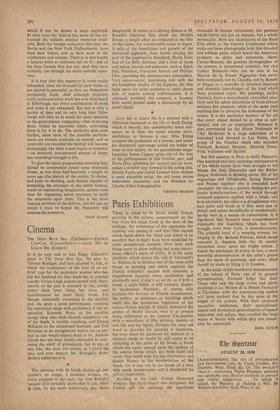Paris Exhibitions
THERE is much to be learnt about French painting in the railway compartment on the way from the coast. Look at the door of the carriage, the robustness of the apparatus for opening and closing it, and that little button which holds down the blind and which is so assertive that it might have been modelled by some unemployed sculptor. Over here such things seem to show nothing but some anony- mous official's sense of utility. It is the same plasticity which makes the raft in Gericault's Le Radeau de la Meduse one of the most solid things in painting and which explains the French architects' success with concrete, a magnificent material when confidently and plastically used. Using it as we do, as if with a brush, a sable brush, it will certainly display its weaknesses. Plasticity, of course, also explains the horrors of French manufacture. the pottery or sculpture or buildings which swell like the monstrous vegetation of the science-fiction worlds. It nearly destroyed the genius of Andre Derain, who is at present being celebrated at the Galerie Charpentier with a miscellany of fifty pictures, mainly of still life and the figure. Perhaps the most apt word to describe his painting is impulsive, for even when he anchored his instincts to a classical mode or model he still seems to be operating at the point of his brush, a brush which too easily spread upon the surface of his canvas forms which are both hard and sweet. One could wish for less rhythmical and plastic fluency. in the manipulation of the brush, for it was not in the hands of a man with much inventiveness and it dissipated his gift of observation.
Reading in the train French illustrated weeklies like. Paris-Matelt one recognises the French gift for selecting the significant moments in human encounters, the gestures which betray not just an impulse, but a whole personality. Here are illustrations of the Ruth Ellis affair or the Geneva Conference which make our news photographs look thin-blooded and without pulse, which brand the American products as shiny and automatic. Henri Cartier-Bresson, the greatest photographer of the present, is exceptional certainly, but also typical. Bonnard—who can be seen at La Maison de la Pens& Fronaise—has never been surpassed, not by Chardin, not by Renoir or Degas, as a recorder of informal meetings and domestic interchanges, of the kind which these pressmen enjoy. His paintings, unlike Derain's, have a marvellously controlled plas- ticity and his subtle distortions of form always enhance this plasticity while at the same time enabling him to preserve the iridescence of his colour. It is the particular mystery of his art that every object should be at once so sub- stantial and yet so impalpable. Bonnard is also represented (at the Musee Nationale de l'Art Moderne) in a large exhibition of a historical kind devoted to Les Nabis, that group of the Nineties which also included Vuillard, Roussel, Serusier, Maurice Denis, Felix Vallotton and Maillol.
But this summer in Paris is really Picasso's. One hundred and forty paintings representative of his whole career have been brought to the Musee des Arts Decoratifs and the Biblio- th&nie Nationale is showing about 280 of his engravings and lithographs. Seeing Bonnard and Picasso together one is reminded hoW absolutely the one is a painter, finding his par- ticular transformations of the world through coloured pigments applied with a brush, and how absolutely the other is a draughtsman who uses paint and brush as if they were pen or pencil, and colour heraldically or symbolically, hardly ever as a means of construction. It is significant that Picasso's most comprehensive statement, the Guernica, whiCh has been brought from New York, is monochromatic. The splendid head of a weeping woman, be- longing to Mr. Roland Penrose, which hangs opposite it, depends little for its similar emotional force upon the bright colour. I found the exhibition of prints, in fact, a more powerful demonstration of the artist's genius than the show of paintings, and every effort should be made to bring it to London.
In the midst of this wonderful demonstration of the school of Paris, one of its greatest representatives, Fernand Leger has died. Those who saw the large circus and picnic paintings in La Maison de la Pensee Francaise at 'Christmas with the accompanying studies will have realised that he has gone at the height of his powers. With their profound masculine tenderness, their marvellously simple and rhythmical generalisation of human behaviour and action, they recalled the large works of Seurat with which they can reason- ably be associated.
BASIL TAYLOR


































 Previous page
Previous page